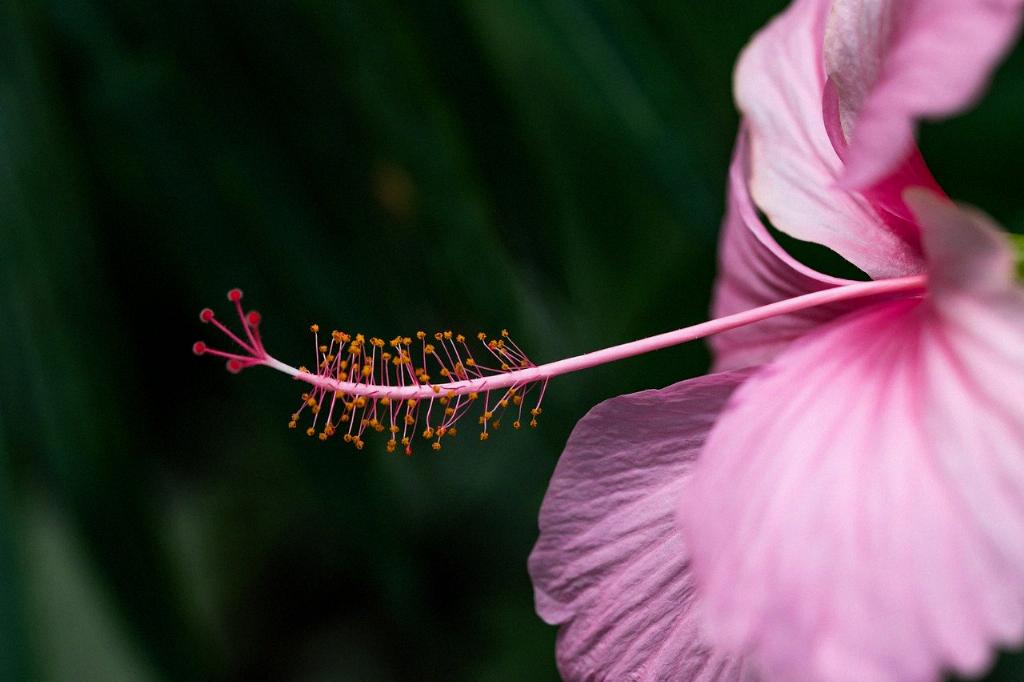When observing a hibiscus plant, one of the first things that catches the eye is its lush greenery. The plant features vibrant, green, semi-glossy leaves that are typically toothed or serrated along the edges. These leaves create a striking contrast against the colorful flowers that the hibiscus is best known for.
Distinctive Flowers
The trademark of a hibiscus plant lies in its spectacular flowers. The flowers are trumpet-shaped and boast a bright and vivid color palette, ranging from shades of red, pink, orange, yellow, and even white. These vibrant hues make hibiscus flowers a popular choice for adding a pop of color to gardens and landscapes.
Multiple Petals
One of the defining features of hibiscus flowers is the numerous petals they possess. Typically, hibiscus flowers flaunt five or more petals, adding to their full and lush appearance. The overlapping petals create a visually appealing backdrop for the prominent central structure of the flower.
Showy Filament
At the heart of a hibiscus flower, a striking filament takes center stage. This filament extends outward from the flower’s center, often matching or complementing the vibrant color of the petals. The showy filament adds an element of elegance and charm to the overall look of the hibiscus bloom.
Central Stamen
Surrounded by the colorful petals and the showy filament, the central stamen of a hibiscus flower beckons attention. The stamen protrudes prominently from the center of the flower, serving as a focal point and contributing to the distinctive appearance of the bloom.
Varied Sizes
While hibiscus plants are generally recognized for their trumpet-shaped flowers, it’s worth noting that these flowers come in a range of sizes. Some hibiscus blooms are small and dainty, while others can be large and commanding, making a bold statement in any garden setting.
Foliage and Growth Pattern
Aside from the striking flowers, the foliage and growth pattern of a hibiscus plant are also noteworthy. The leaves of a hibiscus plant are arranged alternately along the stems, creating a lush and full appearance. The plant itself can vary in size, from compact shrubs to tall trees, offering versatility in landscaping.
Seasonal Blooms
One of the delights of hibiscus plants is their ability to produce blooms throughout the growing season. Depending on the species and variety, hibiscus plants can flower from spring to fall, brightening up outdoor spaces with their colorful and cheerful blossoms.
Flower Lifespan
While hibiscus flowers are undoubtedly eye-catching, it’s essential to appreciate their relatively short lifespan. Individual hibiscus flowers typically last only a day or two before fading and dropping from the plant. However, the hibiscus’s prolific blooming nature ensures a continuous cycle of new flowers.
Adaptability
Hibiscus plants are known for their adaptability to various growing conditions. Whether grown in pots, containers, or garden beds, hibiscus plants can thrive in a range of environments. Their resilience and ability to withstand different climates make them a popular choice for both novice and experienced gardeners.
Landscaping Potential
Given their stunning flowers and lush foliage, hibiscus plants have significant landscaping potential. These versatile plants can be used as standalone features, hedges, or accents in garden beds, adding color, texture, and visual interest to outdoor spaces. Their beauty and ease of care make them a favorite among garden enthusiasts.

Overall Aesthetics
In conclusion, the hibiscus plant is a true marvel of nature, boasting a unique and captivating appearance that captivates the senses. From the vibrant flowers with multiple petals to the showy filaments and lush foliage, hibiscus plants exude beauty and charm in every aspect. Whether admired up close or from afar, the hibiscus plant’s distinctive look is sure to leave a lasting impression on all who encounter it.
